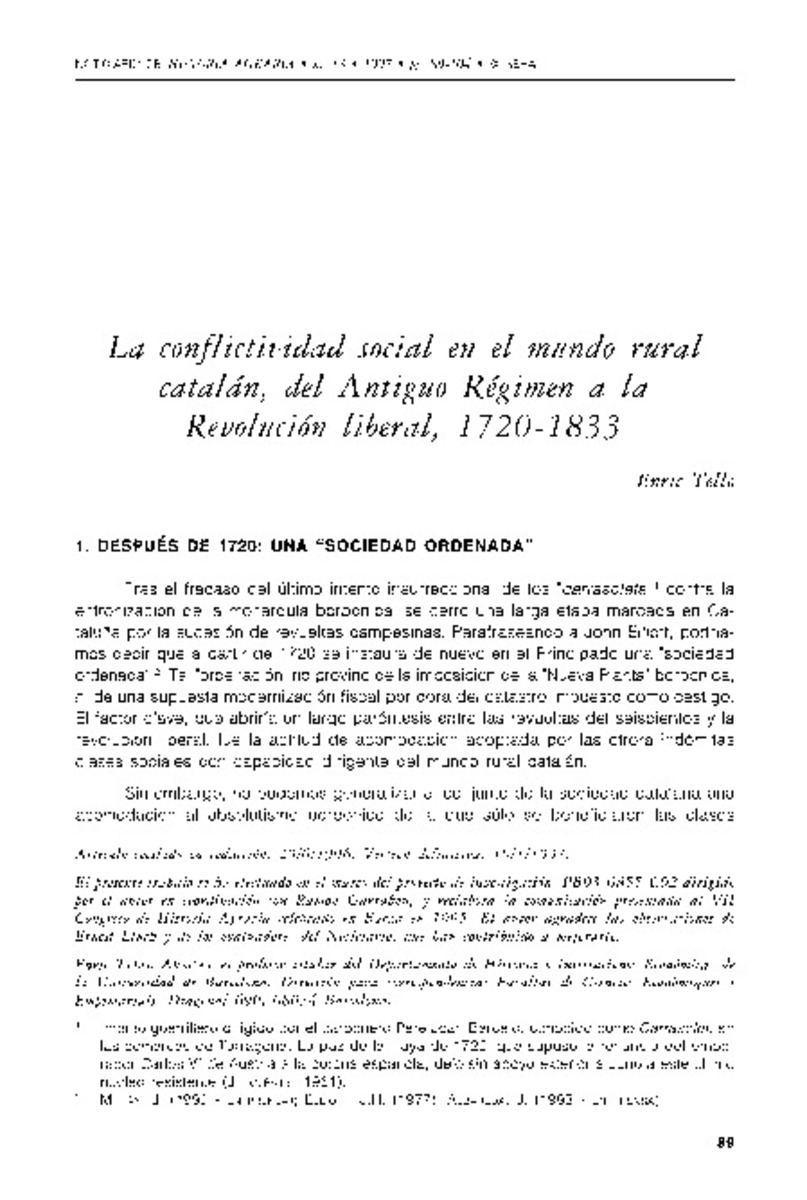Mostrar el registro sencillo del ítem
La conflictividad social en el mundo rural catalán, del Antiguo Régimen a la Revolución liberal, 1720-1833
| dc.contributor.author | Tello, Enric | |
| dc.date.accessioned | 2016-05-10T09:44:08Z | |
| dc.date.available | 2016-05-10T09:44:08Z | |
| dc.date.issued | 1997-01 | |
| dc.identifier.issn | 1139-1472 | |
| dc.identifier.uri | http://hdl.handle.net/10234/159474 | |
| dc.description.abstract | Después de 1720 la acomodación de las clases dirigentes del mundo rural en el marco del absolutismo borbónico permitió la instauración en Cataluña de una "sociedad ordenada" que puso fin a una etapa secular de crisis general. A partir de entonces la conflictividad antiseñorial quedó circunscrita al ámbito local y buscó la reducción de las cargas señoriales para ganar espacio para el crecimiento económico. Hasta 1760 la disminución de la carga feudal por habitante permitió el cultivo de tierras cada vez peores por nuevos contingentes de campesinos precarios. Las rentas feudales aumentaban en volumen. y los campesinos "hacendados" arrendaban la recaudación de los derechos de sus señores. Pero durante el último tercio del siglo XVIII el fin de la expansión agraria y la inflación espolearon una "reacción feudal" postrera. La creciente insumisión campesina puso en entredicho el orden establecido y afectó a todas las rentas, feudales o no. De colaborar con el régimen señorial los "hacendados" pasaron en muchos casos a encabezar la rebelión campesina tratando de encauzarla hacia el nuevo proyecto liberal a partir de las primeras décadas del siglo XIX. | ca_CA |
| dc.description.abstract | After 1720 the accommodation of the rural ruling classes into the new structures of Absolutism led to the establishment of an "orderly society" in Catalonia that put an end to the lasting general crisis of the previous century. Conflicts against the manorial system were limited to the local sphere and mainly directed to gain more room for economic growth. Until 1760, the lowering of manorial charges per inhabitant afforded scores of increasingly poorer peasants to plough increasingly poorer lands. The amount of manorial rents increased too, hence wealthier peasants took part in it by renting the coltection of them on behalf of their landlords. But during the last third of the eighteenth century the end of agrarian growth and Inflation of prices triggered a hindmost feudal reaction". The increasing peasant rebellion against this reaction brought the former "orderly" coexistence to an end, affecting all kinds of rents whether manorial or nol. Many Catalan yeomen ("hisendats") ceased their long-Iasting collaboration with their landlords and started to rule again the peasant revolt, trying to direct it towards the new liberal project which had seen the light during the first decades of the nineteenth century. | ca_CA |
| dc.format.extent | 16 p. | ca_CA |
| dc.format.mimetype | application/pdf | ca_CA |
| dc.language.iso | spa | ca_CA |
| dc.publisher | Sociedad Española de Historia Agraria (SEHA) | ca_CA |
| dc.relation.isPartOf | Historia agraria: Revista de agricultura e historia rural, nº 13, p. 89-104 | ca_CA |
| dc.rights | © SEHA | ca_CA |
| dc.rights.uri | http://rightsstatements.org/vocab/InC/1.0/ | * |
| dc.subject | conflictividad campesina | ca_CA |
| dc.subject | régimen señorial | ca_CA |
| dc.subject | absolutismo | ca_CA |
| dc.subject | revolución liberal | ca_CA |
| dc.subject | diferenciación campesina | ca_CA |
| dc.subject | peasant revolt | ca_CA |
| dc.subject | manorial system | ca_CA |
| dc.subject | Absolutism | ca_CA |
| dc.subject | liberal revolution | ca_CA |
| dc.subject | peasant differentiation | ca_CA |
| dc.title | La conflictividad social en el mundo rural catalán, del Antiguo Régimen a la Revolución liberal, 1720-1833 | ca_CA |
| dc.type | info:eu-repo/semantics/article | ca_CA |
| dc.rights.accessRights | info:eu-repo/semantics/openAccess | ca_CA |
| dc.relation.publisherVersion | http://www.historiaagraria.com/info_articulo.php?id=155 | ca_CA |







